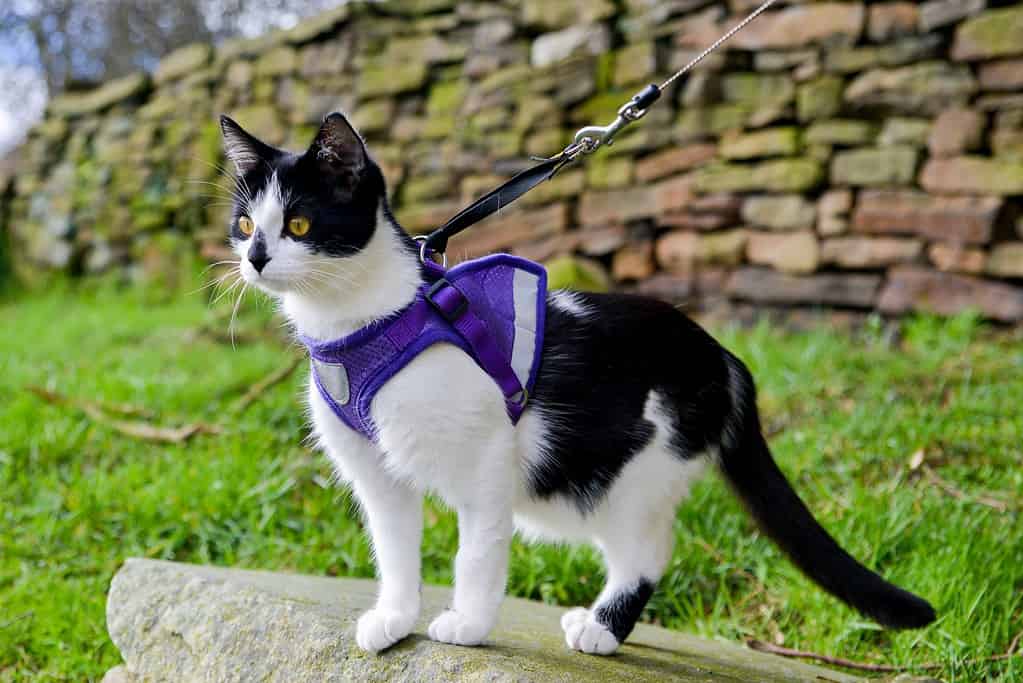There’s no doubt that humans and cats see the world differently, but who sees better? Studies have shown that cats have entirely better night vision than we do. However, it appears we humans can see better in the daytime than our feline friends. Cats certainly see things differently from their point of view.
These differences in vision are due to different receptors that we have within our retinas. Comparing our vision to cats is complicated because there’s no clear-cut answer on who can see better. Both of our species have advantages and disadvantages based on the time of day, amount of light, and distance we are looking.

There’s no doubt that humans and cats see the world differently.
©kimberrywood/Shutterstock.com
Where Cats Take the Lead: Night Vision and Peripheral
Cats are crepuscular animals, meaning that they are naturally more active during dawn and dusk. This is likely why their night and low-light vision is much more powerful than ours. Cats have rod receptors in their eyes that help them see at night and give them a wider range of peripheral vision. Humans also have these receptors, but cats have a lot more, which is why they can see about six to eight times better than we can in the dark.
Their uniquely shaped eyes and large cornea and tapetum also help to reflect light back into their retina. This combination of extra rod receptors and eye tissue that reflects light is how they are able to easily see movement in the dark. This ability to spot prey moving in low light is likely why they are such successful hunters at night.

Cats can quickly spot prey moving in low light.
©Konstantin Zaykov/Shutterstock.com
Peripheral Vision and Field of View
Cats have a wider field of view and range of peripheral vision than we do. Humans have a field of view that is about 180 degrees with a 20-degree peripheral view on each side. Cats can see up to 200 degrees in their field of view with 30 degrees of peripheral vision on each side. This means that in total, cats have about 40 degrees more in terms of how much they can see and spot moving within their vision. The extra rod receptors in their eyes are to thank for these awesome abilities.
Cats vs. Humans: Who Can Go the Distance?
When it comes to seeing things from far away, humans surely take the lead. Compared to the average human vision of 20/20, a cat can see somewhere between 20/100 and 20/200. This means that while we can see something clearly from 100 or 200 feet away, a cat would have to be 20 feet away from it to see it clearly. This also means that most far-away objects and landscapes appear blurry to cats.
Mid-Sighted Cats?
Cats don’t have the muscles in their eyes that allow them to change their eye lenses. This is why far-away objects appear blurry to cats, and they are only able to see clearly at around twenty feet away from something. They’re also lacking in nearsightedness. You’ll notice that if you hold a toy or treat in front of their noses, they are not able to clearly see it. They use their strong sense of smell and sensitive whiskers to feel for it instead.
This means cats have a unique mid-sighted vision that only works from around twenty feet away. Give or take a few feet, and their vision will become blurry very quickly. They have a very small range of middle vision. This means that when it comes to resolution or sharpness of eyesight, humans are certainly the winner.

Cats are only able to see clearly at around twenty feet away from something.
©Abi’s Photos/Shutterstock.com
Where Humans Excel: Daytime and Color Vision
Humans have about ten times more cones, or light receptors, in our eyes than cats do. These light receptors influence how well we are able to see our environment in the daytime, as well as color. Humans also have three different types of cones, each helping us to see red, blue, and green hues vibrantly. Because of these cones, we can see many colors as well as objects in bright light clearly, and detect movement in the daytime easily. We can detect motion in the daytime about twelve times better than our feline friends. This is likely why cats are active mostly at night, because of their limited daytime eyesight and motion detection.
Cats do not have many cones in their eyes, so they cannot see as well in the daytime as we can. They also have more trouble detecting motion in bright light. They share the three types of cones that we humans have, but they have less and a different distribution of them. Because of the fewer cones, a cat’s vision is close to that of a color-blind human.
Some scientists speculate that cats can only see varying hues of blues and grays. Others believe that their vision is closer to that of dogs, who can see blue and yellow hues. Either way, it’s clear that cats see colors and hues less vibrantly than humans and dogs do.

Some scientists believe that cats’ vision is similar to dogs, who can see blue and yellow hues.
©Bachkova Natalia/Shutterstock.com
The photo featured at the top of this post is © kukurund/Shutterstock.com
Thank you for reading! Have some feedback for us? Contact the AZ Animals editorial team.






